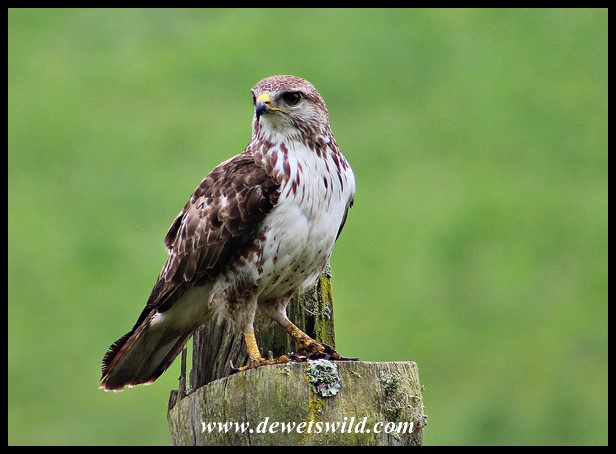Buteo trizonatus
As its name suggests, the Forest Buzzard is an inhabitant of temperate forests and, of late, exotic plantations, where it hunts inside and on the edges of the forest and in clearings for small mammals, birds, reptiles, amphibians and insects, often swooping down from a favourite perch.
Forest Buzzards are usually seen singly or in pairs. Pairs form monogamous bonds and defend a territory against other adults of their kind. Their nests are large stick platforms constructed high above the ground in tall trees. The female lays two eggs in the spring, with the first hatched chick often severely bullying the second, frequently leading to the death of the second through malnutrition. The chick takes its first flight when about 7 weeks old but usually stays with the parents for another 4 months or so before becoming independent. Adults weigh around half a kilogram, with the female being slightly bigger than the male.
The Forest Buzzard is endemic to South Africa. It’s natural distribution is confined to mountainous forests from Cape Town in the west, along the southern coast and adjacent interior through the Western and Eastern Cape Provinces into Kwazulu Natal, and then along the Drakensberg range into Mpumalanga and Limpopo as far north as the Soutpansberg. It would appear that it visits the more northern reaches of this range mainly outside the breeding season. Due to its limited distribution, dependence on threatened habitats and low population (estimated at no higher than 6,700 mature individuals in total) the IUCN lists the Forest Buzzard as being near-threatened. In our experience, the various sections of the Garden Route National Park is the best place to find these beautiful but elusive raptors.









Wow! Sorry to hear so few are left. I like your first photo. It looks so regal.
LikeLiked by 2 people
Thanks, Siobhan. It’s good to know though that the remaining ones are fairly secure.
LikeLiked by 1 person
Such a small number left, Dries.
LikeLiked by 2 people
Very worrisome indeed, Tracy. Thankfully large tracts of what remain of our indigenous forests are well protected.
LikeLiked by 3 people
Yes, thankfully.
LikeLiked by 2 people
Jy is baie bevoorregt om die pragtige Bos Jakkals Voel (Forrest Buzzard) te kon sien.
LikeLiked by 2 people
Ons was regtig gelukkig om dit n hele paar keer raak te loop op die Tuinroete, Aletta, en dat van hul toe nog so mooi gesit het vir hul portrette daarby!
LikeLike
How fortunate to have seen one – they are not always easy to photograph.
LikeLiked by 2 people
Thank you very much, Anne. We were grateful to find a few Forest Buzzards willing to pose when we visited the Garden Route in December.
LikeLiked by 1 person
Such a beautiful bird. I hope that will overcome the shortcomings and be on the list of non- threatened species. Great post, D. 🙂
LikeLiked by 2 people
Thank you, H.J. In reality they were probably never numerous – indigenous forests, while certainly more extensive in historic times, has always been by far the smallest biome by area in South Africa.
LikeLiked by 2 people
That’s the best-looking buzzard I’ve ever seen. Looks more like hawk to me and quite handsome. Pity about the deadly sibling rivalry.
LikeLiked by 2 people
An amusing quirk of the terminology we use, I think, for to us using “British” English a buzzard is a type of hawk, and in North America the name is used in connotation with the new world vultures?
LikeLiked by 1 person
OK, that makes sense. I just looked it up and got a better idea of how the terms are used in and out of the US. Makes sense now.
LikeLiked by 2 people
The first hatched is a bully….that is so sad.
LikeLiked by 2 people
Seems a trend with most of our raptors, Lois. Toughness is required right from the start.
LikeLiked by 1 person